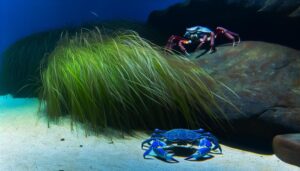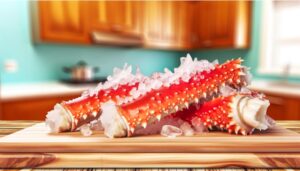Do Large Ghost Crabs Attack Smaller Ones?
Yes, king crabs likely feel pain. They possess nociceptors, which detect harmful stimuli, and exhibit physiological responses akin to nociception.
Their decentralized nervous system effectively processes these signals, indicating potential pain perception. Behavioral responses such as limb retraction, prolonged avoidance, and stress-induced behavior further support this.
Increasing scientific evidence aligns with the broader understanding of pain in various species, urging ethical considerations in current handling practices. To uncover more about the complexities of pain perception in king crabs and how it impacts industry standards, exploring the latest research can provide deeper insights.

Key Takeaways
- King crabs possess nociceptors that detect harmful stimuli, suggesting a capacity for pain perception.
- Behavioral responses like limb retraction and grooming indicate potential pain experience in king crabs.
- Physiological studies show stress-induced behaviors in king crabs following harmful stimuli.
- The decentralized nervous system of king crabs efficiently processes nociceptive signals.
- Ethical considerations arise from scientific evidence supporting pain perception in king crabs, impacting industry practices.
Understanding Pain
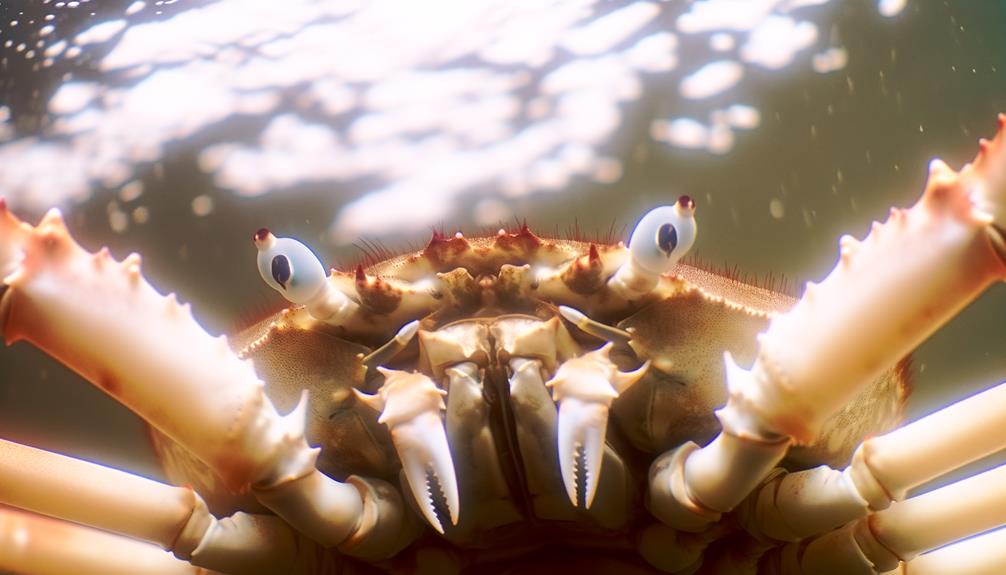
Understanding pain involves examining the biological mechanisms that trigger nociception, which is the sensory nervous system's response to potentially harmful stimuli.
When you encounter a painful stimulus, nociceptors, specialized sensory receptors, detect this and send signals through your peripheral nerves to your spinal cord and brain. These signals are then processed, resulting in the sensation of pain.
Nociception is essential for survival as it prompts you to withdraw from harmful situations, facilitating self-preservation. Research indicates that the perception of pain isn't merely a simple reflex but involves complex neural pathways and the central nervous system.
Nervous Systems of Crabs
You should start by examining the neural structure of crabs, which includes a decentralized nervous system.
Evidence suggests the presence of nociceptors, specialized pain receptors, in crabs.
Additionally, observe behavioral indicators that may signify a pain response, such as changes in activity or grooming behavior.
Neural Structure Overview
Crabs possess a decentralized nervous system characterized by a ventral nerve cord and a series of ganglia that coordinate their sensory and motor functions. This system allows crabs to process information locally rather than relying on a centralized brain.
Each ganglion acts as a mini-brain, handling tasks like movement, reflex actions, and environmental responses. This neural structure is efficient, enabling crabs to adapt quickly to their surroundings.
Sensory neurons in the crabs' exoskeleton detect stimuli such as touch and temperature, transmitting signals to the ganglia. Motor neurons then relay commands to muscles, facilitating movement.
Understanding this neural architecture offers insights into how crabs interact with their environment, enhancing our comprehension of their behavior and survival mechanisms.
Pain Receptor Presence
Recent research has identified nociceptors in crabs, suggesting they possess the biological capability to detect and respond to potentially harmful stimuli. Nociceptors are specialized sensory neurons that react to pain-inducing stimuli by transmitting signals to the central nervous system.
In crabs, these receptors are found in various body parts, enabling them to perceive physical damage or extreme conditions.
You might find it intriguing that the existence of nociceptors indicates a sophisticated nervous system capable of processing pain signals. This finding challenges assumptions about invertebrate perception and sparks discussions about their well-being.
Behavioral Pain Indicators
Behavioral studies have demonstrated that crabs exhibit avoidance behaviors and protective responses when exposed to noxious stimuli, indicating a potential capacity for pain perception. These studies highlight several key behavioral indicators:
- Escape Responses: Crabs rapidly flee from harmful stimuli.
- Grooming and Rubbing: They frequently attend to affected areas, suggesting discomfort.
- Protective Postures: They adopt defensive stances to shield injured parts.
- Learned Avoidance: Crabs avoid areas where they've previously encountered painful experiences.
You can see these behaviors as evidence that crabs might experience pain, driven by their nervous systems' responses. For those valuing freedom, acknowledging the potential for pain in crabs can inform more compassionate practices, ensuring their welfare aligns with ethical standards.
Scientific Research
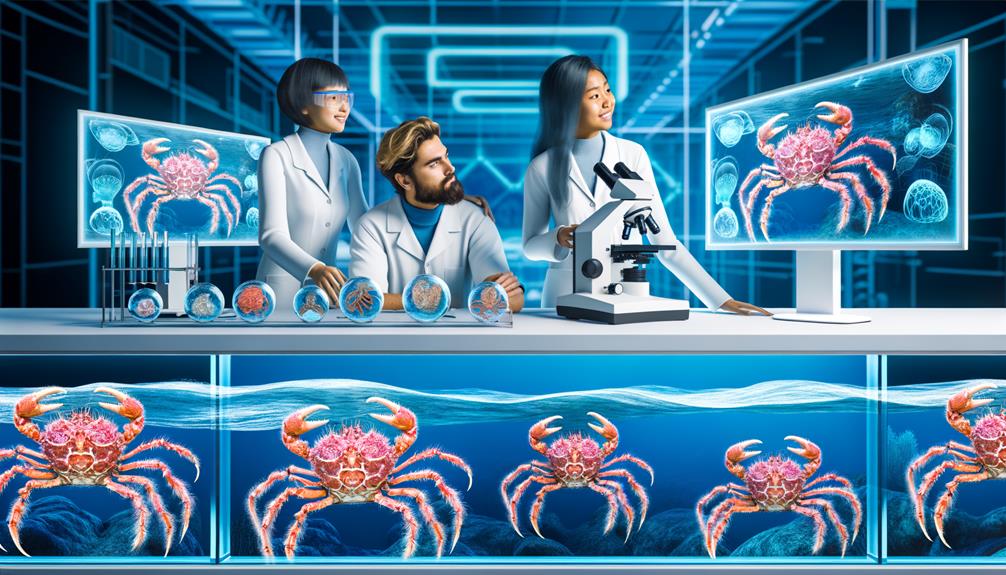
Studies in comparative neurobiology provide compelling evidence regarding the nociceptive capabilities of king crabs. Researchers have identified nociceptors in king crabs, suggesting they can detect harmful stimuli. These nociceptors are specialized sensory neurons responsible for signaling potential tissue damage to the brain. This aligns with the broader understanding of nociception in various species, not just vertebrates.
In controlled experiments, king crabs exhibit physiological responses, such as stress-induced changes in heart rate, when exposed to nociceptive stimuli. Their nervous system's complexity supports the hypothesis that these responses aren't merely reflexive but indicative of a more integrated processing of harmful stimuli.
As a result, the scientific community increasingly acknowledges that king crabs likely experience nociceptive pain.
Behavioral Indicators
When evaluating whether king crabs feel pain, it's essential to examine their behavioral indicators. Reflexive responses, such as twitching or limb retraction, suggest a reaction to noxious stimuli.
Additionally, stress-induced behaviors like prolonged avoidance or changes in movement patterns offer further evidence of potential pain perception.
Reflexive Responses Observed
Researchers have documented that king crabs exhibit specific reflexive responses when subjected to potentially harmful stimuli, suggesting a complex behavioral repertoire. These responses are critical to understanding whether these animals experience pain or merely react reflexively.
Notable observations include:
- Immediate withdrawal: King crabs rapidly retract their limbs from noxious stimuli.
- Increased grooming: Crabs frequently groom the affected area, indicating awareness of discomfort.
- Prolonged avoidance: They avoid areas where they've previously encountered harmful stimuli.
- Defensive postures: Crabs adopt protective stances, shielding vulnerable body parts.
These behaviors imply that king crabs possess intricate neural mechanisms enabling them to respond to threats.
Stress-Induced Behaviors
In examining stress-induced behaviors, you'll notice that king crabs display specific actions such as increased hiding and reduced feeding, which serve as clear behavioral indicators of distress.
When subjected to potentially harmful stimuli, these crabs tend to seek shelter more frequently, minimizing exposure to perceived threats. Additionally, a notable decrease in their feeding activity suggests an altered physiological state.
These behaviors, supported by observational data, highlight the crabs' response mechanisms to stress. The presence of such indicators may imply a capacity for experiencing discomfort or pain.
Ethical Considerations
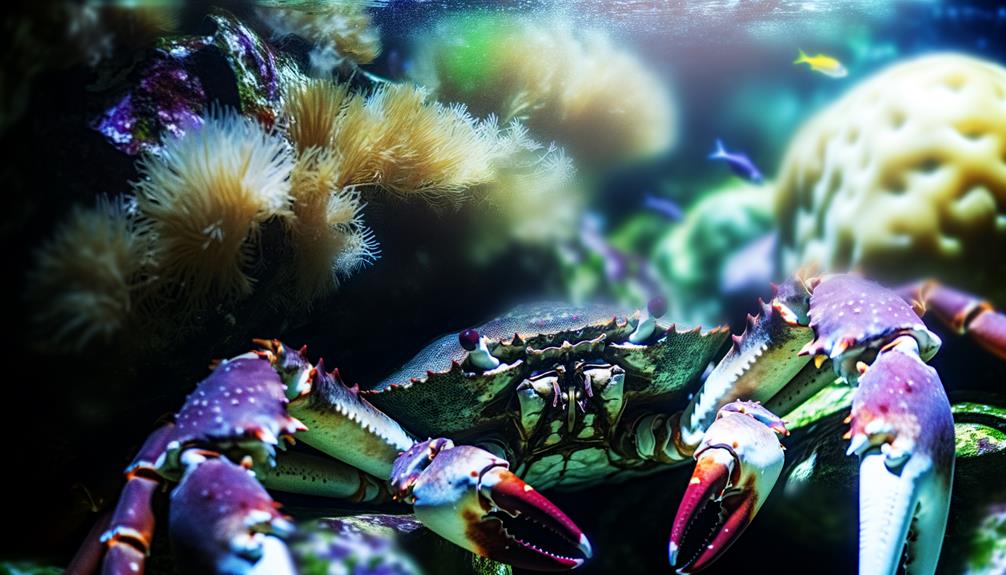
Evaluating the ethical perspectives on whether king crabs feel pain requires a thorough examination of scientific evidence and moral frameworks. You must weigh the available data on nociception and behavioral responses to potentially painful stimuli.
Here are critical questions to contemplate:
- Scientific Evidence: Does current research support the idea that king crabs experience pain similar to vertebrates?
- Moral Responsibility: If king crabs can feel pain, what ethical obligations do we have to minimize their suffering?
- Impact on Fisheries: How might recognizing crustacean pain affect commercial fishing practices and regulations?
- Consumer Choices: Would knowing that king crabs feel pain influence your decisions as a consumer?
Your analysis should balance freedom of choice with a commitment to humane practices, ensuring informed decisions.
Comparative Studies
Frequently, comparative studies examine the physiological and behavioral responses of king crabs alongside other crustaceans to assess similarities in their capacity for nociception. These studies often compare neural pathways, stress responses, and behavioral changes in various species. You'll find that researchers look at both immediate reactions and longer-term adaptations to potentially painful stimuli.
Here's a simplified comparison:
| Aspect | King Crabs | Other Crustaceans |
|---|---|---|
| Neural Pathways | Complex | Varies |
| Stress Hormones | Elevated | Elevated |
| Behavioral Changes | Avoidance | Avoidance |
| Long-term Adaptation | Possible | Observed |
Industry Practices
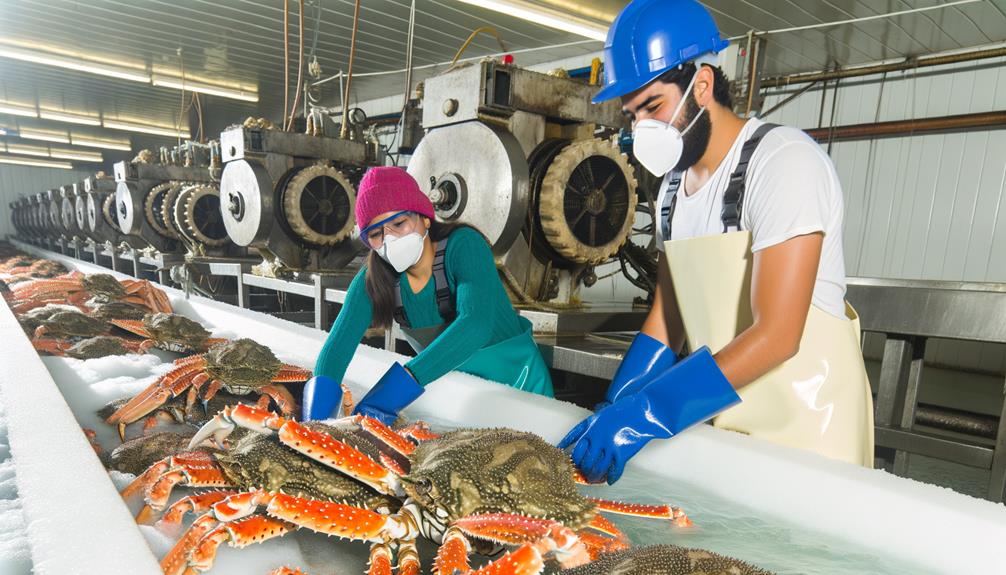
Examining industry practices reveals how commercial fishing and handling of king crabs may impact their potential to experience pain, as suggested by comparative studies on nociception. When you look closely, you'll notice several key areas of concern:
- Trapping Methods: Crabs are often caught in traps that can cause physical injury.
- Handling Procedures: Rough handling during transport can lead to stress and possible harm.
- Environmental Conditions: Crabs are sometimes held in tanks with poor water quality, affecting their well-being.
- Processing Techniques: Some methods of killing crabs mightn't guarantee a quick and humane death.
Each of these factors can contribute to the potential suffering of king crabs, raising ethical questions about current industry standards.
Future Research
To advance our understanding of whether king crabs feel pain, future research should prioritize developing more refined methods for evaluating nociceptive responses in these crustaceans.
You should employ techniques such as electrophysiological recordings to measure neural activity, and behavioral assays to observe reactions to potentially noxious stimuli.
Comparative studies with other crustaceans known to exhibit nociception can provide valuable insights.
Additionally, molecular analysis of pain-related genes and neurotransmitters will help elucidate the underlying mechanisms.
Addressing these areas won't only enhance our scientific knowledge but also inform ethical considerations in the seafood industry.
Conclusion
To sum up, taking into account current scientific studies and behavioral indicators, it's evident that king crabs likely experience pain. Their intricate nervous systems, along with observable distress behaviors, highlight this sensitivity.
Ethical considerations and industry practices should shift towards more humane treatment. Future research, concentrating on finer neural mechanisms and comparative studies, will further shed light on this pressing predicament.
By embracing compassionate practices, we can guarantee a more ethical approach to how we interact with these intricate invertebrates.


